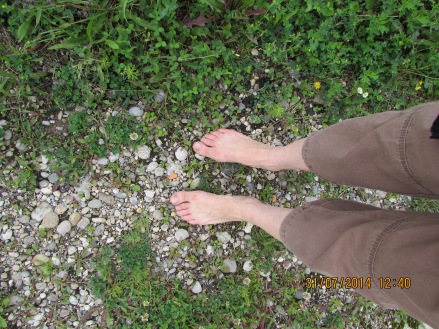Once I read an Ethiopian story about Adam and Eve. It narrated as follows. Adam and Eve lived as light beings solely in spirit in a sacred way. They were all made out of sacred light. They lived in the Garden of Eden, where they didn’t need to eat, drink and digest, dress and so forth. All the material part of life we know was absent. Then one day some mischievous spiritual being caught them into a trap by sending them the idea to eat a fruit of a tree. They fell into this trap, took a bite and were banished from the Garden of Eden. After they were thrown out, they got their physical bodies or their light bodies somehow solidified. First, they were so hurt, because they had to eat that they wanted to die. Nevertheless, they were somehow encouraged or even forced to exist in that new material world, where they had to eat, digest and dress. They felt very ashamed of the newly acquired physical characteristics of their materialized existence. No matter how they tried to return to the Garden of Eden into purity of sacred light or perish in their materialized existence, they were forced to exist further on in their physical existence and even procreate.
Now look at where this banishment out of sacred light of existence has brought the humankind. Except for some breatharians and those who live by the sunlight, the majority of us are eating other beings’ children (fruits, seeds, etc.) or bodies of grown up beings. It looks like we have turned into Hansels and Gretchens where our minds are being kept in a trap, where given ideas feed our minds similar to the way the witch fed Hansel and Gretchen when they were kept in her cage. The settings (cage) are more technically equipped and comfortable nowadays, but the general idea is very similar. So, we believe what we are told, whether true or not.
Some years ago many people were using a particular diary product, advertised as a particularly good for bowels. Some years later a research proved that that diary product isn’t any better than any else. By then many people’s minds were kept in a trap of the advertised idea.
See, milk is healthy only as much as the cow is healthy and eating her natural chosen food. Some decades ago, I spent a month in high mountains as a herdsman’s assistant. Cows were grazing and running freely and eating only fresh grass, even if they went in search for it half the mountain top away. They would never even try the grass upon which some fertilizing agents were strewn. Their milk scented of flowering wild mountain flowers and grasses they ate and its thickness was consistent even if it was left in a container. We have been making cheese, sweet quark, and sweet cream, butter and sour milk and sour cream out of their fresh, unpasteurized and unhomogenized milk. It worked. We poured milk into a cup and left it stay for three days and got sour milk with some sour cream upon it. Now, if I buy a bottle of milk out of an automat its thickness will not remain consistent and I would not be able to make sour milk out of it.
There are worse cases of captivity then the upper example of advertisement. Maybe, if we can switch off the mind feeders for a while, then perhaps we would be able to hear what our own body is telling us or even our own thoughts.


